二年级朗文英语下册B语法知识点归纳
二年级朗文英语下册(2B)语法知识点归纳
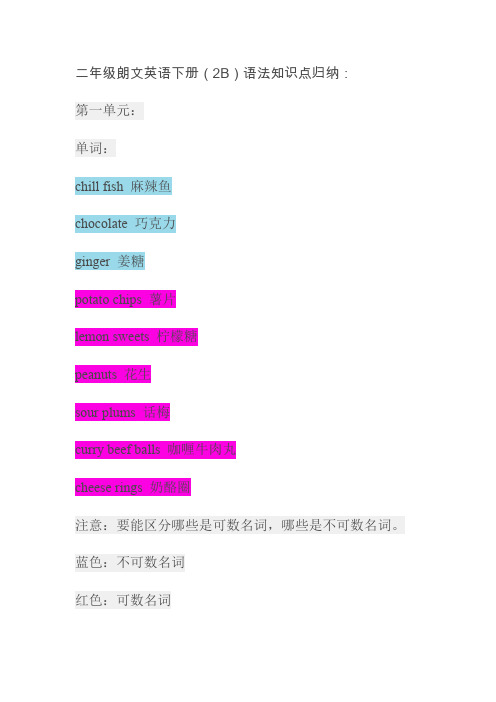
二年级朗文英语下册(2B)语法知识点归纳:第一单元:单词:chill fish 麻辣鱼chocolate 巧克力ginger 姜糖potato chips 薯片lemon sweets 柠檬糖peanuts 花生sour plums 话梅curry beef balls 咖喱牛肉丸cheese rings 奶酪圈注意:要能区分哪些是可数名词,哪些是不可数名词。
蓝色:不可数名词红色:可数名词句型:1.太多了too much 用于不可数名词too many 用于可数名词2. I like cookies. 我喜欢饼干。
3. Do you like cookies? 你喜欢饼干吗?肯定回答:Yes, I do.否定回答:No, I don’t.4. I don’t like cookies. 我不喜欢饼干。
5. Beeno likes cookies. Beeno喜欢吃饼干。
(Beeno是第三人称单数,后面的动词like加s)6. Does Beeno like cookies? Beeno喜欢吃饼干吗?(有了does,like不加s)肯定回答:Yes, he does.否定回答:No, he doesn’t.7. Beeno doesn’t like cookies. Beeno不喜欢吃饼干。
有does或者是doesn’t,后面的动词like就不加s了。
第二单元单词:grape 葡萄grapes 葡萄(复数)orange 桔子oranges 桔子(复数)egg 鸡蛋eggs 鸡蛋(复数)sugar 糖flour 面粉butter 黄油注意:要能区分哪些是可数名词,哪些是不可数名词。
蓝色:不可数名词红色:可数名词句型:1.这里有…吗?①Is there any ….? 用于询问不可数名词。
例如:Is there any butter?肯定回答:Yes, there is.否定回答:No, there isn’t.②Are there any …? 用于询问可数名词,后接名词的复数形式。
朗文下册(2B知识点归纳复习过程

朗文下册(2B知识点归纳复习过程-CAL-FENGHAI-(2020YEAR-YICAI)_JINGBIAN二年级朗文英语下册(2B)语法知识点归纳:第一单元:单词:chill fish 麻辣鱼chocolate 巧克力ginger 姜糖potato chips 薯片lemon sweets 柠檬糖peanuts 花生sour plums 话梅curry beef balls 咖喱牛肉丸cheese rings 奶酪圈注意:要能区分哪些是可数名词,哪些是不可数名词。
蓝色:不可数名词红色:可数名词句型:1.太多了too much 用于不可数名词too many 用于可数名词2. I like cookies. 我喜欢饼干。
3. Do you like cookies 你喜欢饼干吗肯定回答:Yes, I do.否定回答:No, I don’t.4. I don’t like cookies. 我不喜欢饼干。
5. Beeno likes cookies. Beeno喜欢吃饼干。
(Beeno是第三人称单数,后面的动词like加s)6. Does Beeno like cookies Beeno喜欢吃饼干吗(有了does,like不加s)肯定回答:Yes, he does.否定回答:No, he doesn’t.7. Beeno doesn’t like cookies. Beeno不喜欢吃饼干。
有does或者是doesn’t,后面的动词like就不加s了。
第二单元单词:grape 葡萄grapes 葡萄(复数)orange 桔子oranges 桔子(复数)egg 鸡蛋eggs 鸡蛋(复数)sugar 糖flour 面粉butter 黄油注意:要能区分哪些是可数名词,哪些是不可数名词。
蓝色:不可数名词红色:可数名词句型:1.这里有…吗①Is there any …. 用于询问不可数名词。
例如:Is there any butter肯定回答:Yes, there is.否定回答:No, there isn’t.②Are there any … 用于询问可数名词,后接名词的复数形式。
二年级朗文英语下册(2B)语法知识点归纳
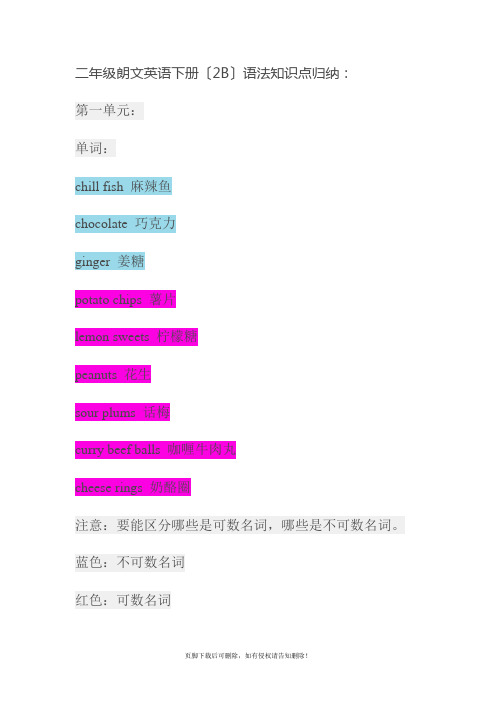
二年级朗文英语下册〔2B〕语法知识点归纳:第一单元:单词:chill fish 麻辣鱼chocolate 巧克力ginger 姜糖potato chips 薯片lemon sweets 柠檬糖peanuts 花生sour plums 话梅curry beef balls 咖喱牛肉丸cheese rings 奶酪圈注意:要能区分哪些是可数名词,哪些是不可数名词。
蓝色:不可数名词红色:可数名词句型:too much 用于不可数名词too many 用于可数名词2. I like cookies. 我喜欢饼干。
3. Do you like cookies? 你喜欢饼干吗?肯定答复:Yes, I do.否认答复:No, I don’t.4. I don’t like cookies. 我不喜欢饼干。
5. Beeno likes cookies. Beeno喜欢吃饼干。
〔Beeno是第三人称单数,后面的动词like加s〕6. Does Beeno like cookies? Beeno喜欢吃饼干吗?〔有了does,like不加s〕肯定答复:Yes, he does.否认答复:No, he doesn’t.7. Beeno doesn’t like cookies. Beeno不喜欢吃饼干。
有does或者是doesn’t,后面的动词like就不加s了。
第二单元单词:grape 葡萄grapes 葡萄〔复数〕orange 桔子oranges 桔子〔复数〕egg 鸡蛋eggs 鸡蛋〔复数〕sugar 糖flour 面粉butter 黄油注意:要能区分哪些是可数名词,哪些是不可数名词。
蓝色:不可数名词红色:可数名词句型:1.这里有…吗?①Is there any ….? 用于询问不可数名词。
例如:Is there any butter?肯定答复:Yes, there is.否认答复:No, there isn’t.②Are there any …? 用于询问可数名词,后接名词的复数形式。
最新二年级朗文英语下册(2B)语法知识点归纳
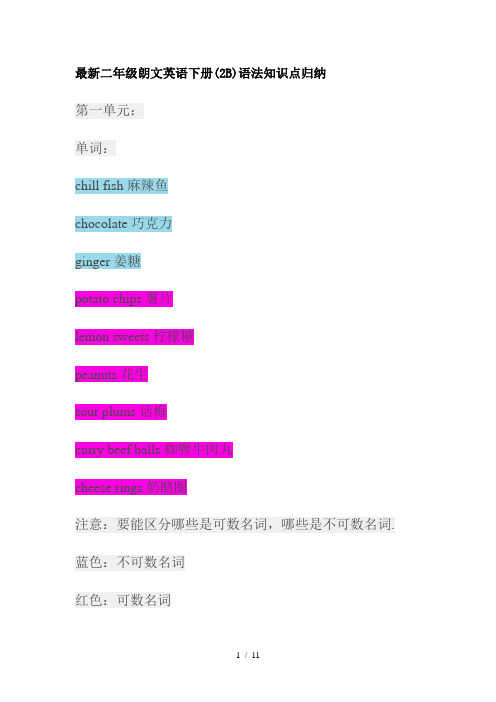
最新二年级朗文英语下册(2B)语法知识点归纳第一单元:单词:chill fish 麻辣鱼chocolate 巧克力ginger 姜糖potato chips 薯片lemon sweets 柠檬糖peanuts 花生sour plums 话梅curry beef balls 咖喱牛肉丸cheese rings 奶酪圈注意:要能区分哪些是可数名词,哪些是不可数名词.蓝色:不可数名词红色:可数名词句型:1.太多了too much 用于不可数名词too many 用于可数名词2. I like cookies. 我喜欢饼干.3. Do you like cookies? 你喜欢饼干吗?肯定回答:Yes, I do.否定回答:No, I don’t.4. I don’t like cookies. 我不喜欢饼干.5. Beeno likes cookies.Beeno喜欢吃饼干.(Beeno是第三人称单数,后面的动词li ke加s)6. Does Beeno like cookies?Beeno喜欢吃饼干吗?(有了does,like不加s)肯定回答:Yes, he does.否定回答:No, he doesn’t.7. Beeno doesn’t like cookies. Beeno不喜欢吃饼干.有does或者是doesn’t,后面的动词like就不加s了.第二单元单词:grape 葡萄grapes 葡萄(复数)orange 桔子oranges 桔子(复数)egg 鸡蛋eggs 鸡蛋(复数)sugar 糖flour 面粉butter 黄油注意:要能区分哪些是可数名词,哪些是不可数名词.蓝色:不可数名词红色:可数名词句型:1.这里有…吗?①Is there any ….? 用于询问不可数名词.例如:Is there any butter?肯定回答:Yes, there is.否定回答:No, there isn’t.②Are there any …?用于询问可数名词,后接名词的复数形式.例如:Are there any eggs?肯定回答:Yes, there are.否定回答:No, there aren’t.2. 这里有….①There is… 后接可数名词的单数或者不可数名词.例如:There is an egg.There is some butter.②There are … 后接可数名词的复数.不可以接不可数名词.例如:There are some eggs.第三单元:单词:wash my face 洗脸brush my teeth 刷牙have breakfast 吃早饭do my homework 做作业have a shower 洗澡go to bed 睡觉句型:1. It’s time to…到了做…的时间了to 的后面接动词原形2.问现在几点了?Wha t’s the time?What time is it?3. 回答时间:It’s 后接时间.4. 在早上in the morning在下午in the afternoon在晚上in the evening5. 在深夜 at night6. 在…时间 at+时间点7. 第三人称单数后面的动词,加s或者es wash – washesbrush – brusheshave – hasdo – doesgo – goes第四单元:单词:wash the dishes 洗碗set the table 摆碗筷water the plants 浇水sweep the floor 扫地tidy the living room 整理客厅make the bed 铺床句型:1. How do you help at home? 你在家干什么活?2. I set the table.3. How does Beeno help at home? Beeno在家干什么活?4. He sets the table.Beeno (人名、he 、she)第三人称单数,后接的动词加s但是,以o、ch、sh结尾的动词,要加es,比如go、watch 、wash.5. 第三人称单数后面的动词,加s或者eswash – washesset – setswater – waters sweep – sweeps tidy – tidiesmake – makes第五单元:单词:football 足球basketball 篮球volleyball 排球badminton 羽毛球tennis 网球table tennis 乒乓球句型:1. What do you like doing? 你喜欢做什么?2. I like playing football. 球类运动前面要用动词play. like后面接的动词要加ing.3. Do you like running? 你喜欢跑步吗?肯定回答:Yes, I do.第六单元:单词:Sunday 周日Monday 周一Tuesday 周二Wednesday 周三Thursday 周四Friday 周五Saturday 周六go hiking 去爬山go cycling 去骑车go dancing 去跳舞go swimming 去游泳go ice-skating 去滑冰go jogging 去慢跑句型:星期几的前面要用介词“on”3. What does Beeno/ he/ she do on Monday?Beeno he she 是第三人称单数,所以前面的do变成了does 4. He/ She goes cycling.He 或者She是第三人称单数,所以后面的动词要加“s”,但是以“o ch sh”结尾的动词,结尾改加“es”.They go cycling.虽然they也是第三人称,但是they表示“他们”,是复数.所以动词仍然用原型.11 / 11。
朗文下册(2B知识点归纳复习过程

朗文下册(2B知识点归纳复习过程二年级朗文英语下册(2B)语法知识点归纳:第一单元:单词:chill fish麻辣鱼chocolate巧克力ginger姜糖注意:要能区分哪些是可数名词,哪些是不可数名词。
蓝色:不可数名词句型:1・太多了too much用于不可数名词too many用于可数名词2.1like cookies.我喜欢饼干。
3.Do you like cookies你喜欢饼干吗肯定回答:Yes, I do.否定回答:No, I dont4.1don't like cookies.我不喜欢饼干。
5.Beeno likes cookies. Beeno 喜欢吃饼干。
(Beeno 是第三人称单数,后面的动词like加s)6.Does Beeno like cookies Beeno 喜欢吃饼干吗(有了does, like 不加s)肯定回答:Yes, he does.否定回答:No, he doesn't・7.Beeno doesn't like cookies. Beeno 不喜欢吃饼干。
有does或者是doesn't,后面的动词like就不加s 了。
第二单元单词:注意:要能区分哪些是可数名词,哪些是不可数名词。
蓝色:不可数名词句型:1 •这里有…吗①Is there any ....用于询问不可数名词。
例如:Is there any butter肯定回答:Yes, there is.否定回答:No, there isn't.②Are there any ...用于询问可数名词,后接名词的复数形式。
例女口:Are there any eggs肯定回答:Yes, there are.否定回答:No, there aren't.2.这里有…。
©There is...后接可数名词的单数或者不可数名词。
例如:There is an egg.There is some butter.©There are ...后接可数名词的复数。
朗文下册(2B知识点归纳
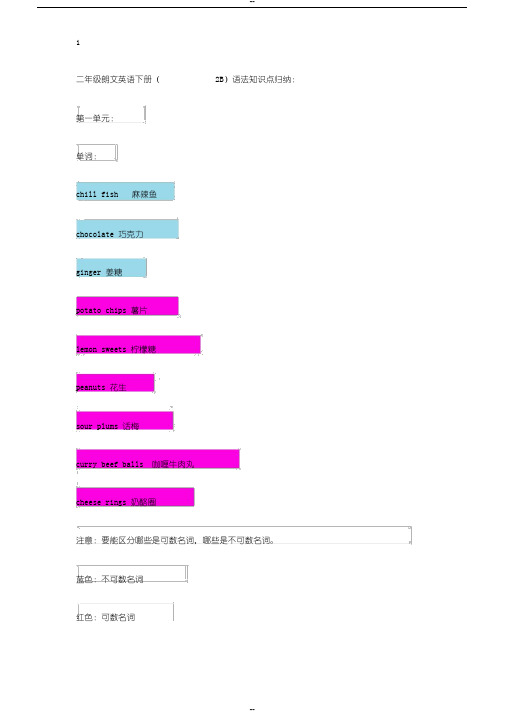
二年级朗文英语下册(2B)语法知识点归纳:第一单元:单词:chill fish 麻辣鱼chocolate 巧克力ginger 姜糖potato chips 薯片lemon sweets 柠檬糖peanuts 花生sour plums 话梅curry beef balls 咖喱牛肉丸cheese rings 奶酪圈注意:要能区分哪些是可数名词,哪些是不可数名词。
蓝色:不可数名词红色:可数名词句型:1.太多了too much 用于不可数名词too many 用于可数名词2.I like cookies. 我喜欢饼干。
3.Do you like cookies? 你喜欢饼干吗?肯定回答: Yes,I do.否定回答: No, I don ’t.4. I don ’ t like cookies我不.喜欢饼干。
5. Beeno likes cookies. Beeno 喜欢吃饼干。
( Beeno 是第三人称单数,后面的动词 like 加 s)6. Does Beeno like cookies? Beeno 喜欢吃饼干吗?(有了does,like 不加 s)肯定回答: Yes, he does.否定回答: No, he doesn ’t.7. Beeno doesn ’ t like cookies. Beeno不喜欢吃饼干。
有does 或者是 doesn’t,后面的动词 like 就不加 s 了。
第二单元单词:grape 葡萄grapes 葡萄(复数)orange 桔子oranges 桔子(复数)egg 鸡蛋eggs 鸡蛋(复数)sugar 糖flour 面粉butter 黄油注意:要能区分哪些是可数名词,哪些是不可数名词。
蓝色:不可数名词红色:可数名词句型:1.这里有⋯吗?①Is there any ⋯用.?于询问不可数名词。
例如: Is thereany butter?肯定回答: Yes, there is.否定回答: No, there isn ’t.②Are there any ⋯用?于询问可数名词,后接名词的复数形式。
朗文下册B知识点归纳
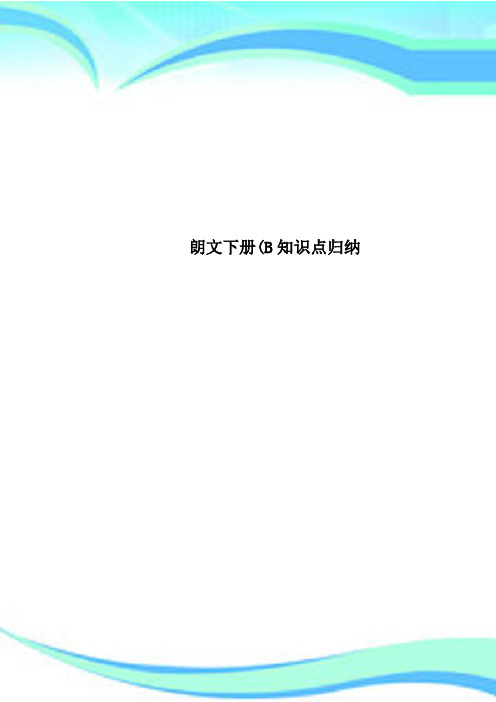
朗文下册(B知识点归纳————————————————————————————————作者: ————————————————————————————————日期:二年级朗文英语下册(2B)语法知识点归纳:第一单元:单词:chill fish 麻辣鱼chocolate巧克力ginger姜糖potato chips薯片lemon sweets 柠檬糖peanuts 花生sourplums 话梅currybeefballs咖喱牛肉丸cheeserings 奶酪圈注意:要能区分哪些是可数名词,哪些是不可数名词。
蓝色:不可数名词红色:可数名词句型:1.太多了toomuch 用于不可数名词too many用于可数名词2. I likecookies. 我喜欢饼干。
3. Doyou like cookies? 你喜欢饼干吗?肯定回答:Yes, I do.否定回答:No, I don’t.4.I don’t likecookies.我不喜欢饼干。
5.Beeno likescookies. Beeno喜欢吃饼干。
(Beeno是第三人称单数,后面的动词like加s)6.Does Beeno like cookies?Beeno喜欢吃饼干吗?(有了does,like不加s)肯定回答:Yes, he does.否定回答:No, he doesn’t.7. Beenodoesn’t likecookies.Beeno不喜欢吃饼干。
有does或者是doesn’t,后面的动词like就不加s了。
第二单元单词:grape葡萄grapes 葡萄(复数)orange 桔子oranges 桔子(复数)egg 鸡蛋eggs鸡蛋(复数)sugar 糖flour面粉butter黄油注意:要能区分哪些是可数名词,哪些是不可数名词。
蓝色:不可数名词红色:可数名词句型:1.这里有…吗?①Is there any….? 用于询问不可数名词。
例如:Is thereany butter?肯定回答:Yes,there is.否定回答:No, thereisn’t.②Arethere any…? 用于询问可数名词,后接名词的复数形式。
二年级朗文英语下册(2B)语法知识点归纳(K12教育文档)

二年级朗文英语下册(2B)语法知识点归纳(word版可编辑修改)编辑整理:尊敬的读者朋友们:这里是精品文档编辑中心,本文档内容是由我和我的同事精心编辑整理后发布的,发布之前我们对文中内容进行仔细校对,但是难免会有疏漏的地方,但是任然希望(二年级朗文英语下册(2B)语法知识点归纳(word版可编辑修改))的内容能够给您的工作和学习带来便利。
同时也真诚的希望收到您的建议和反馈,这将是我们进步的源泉,前进的动力。
本文可编辑可修改,如果觉得对您有帮助请收藏以便随时查阅,最后祝您生活愉快业绩进步,以下为二年级朗文英语下册(2B)语法知识点归纳(word版可编辑修改)的全部内容。
二年级朗文英语下册(2B)语法知识点归纳:第一单元:单词:chill fish 麻辣鱼chocolate 巧克力ginger 姜糖potato chips 薯片lemon sweets 柠檬糖peanuts 花生sour plums 话梅curry beef balls 咖喱牛肉丸cheese rings 奶酪圈注意:要能区分哪些是可数名词,哪些是不可数名词.蓝色:不可数名词红色:可数名词句型:1。
太多了too much 用于不可数名词too many 用于可数名词2。
I like cookies. 我喜欢饼干。
3。
Do you like cookies? 你喜欢饼干吗?肯定回答:Yes, I do。
否定回答:No, I don't.4. I don’t like cookies。
我不喜欢饼干。
5。
Beeno likes cookies. Beeno喜欢吃饼干.(Beeno是第三人称单数,后面的动词like加s)6。
Does Beeno like cookies? Beeno喜欢吃饼干吗?(有了does,like不加s)肯定回答:Yes, he does.否定回答:No, he doesn’t。
7. Beeno doesn’t like cookies。
最新版朗文英语2B知识点总结
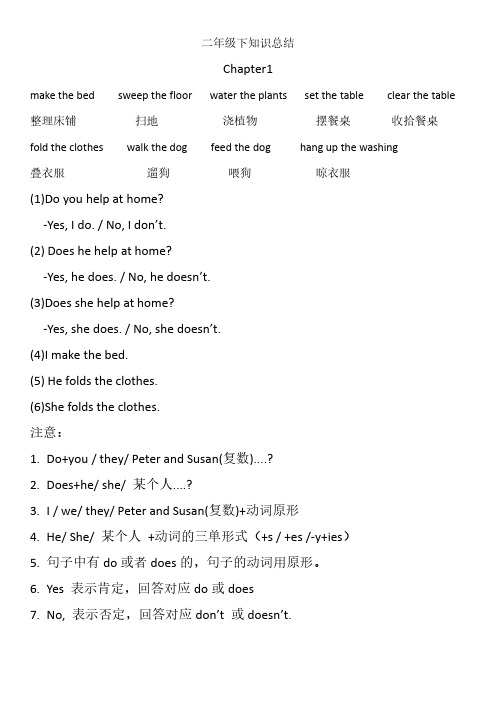
二年级下知识总结Chapter1make the bed sweep the floor water the plants set the table clear the table 整理床铺扫地浇植物摆餐桌收拾餐桌fold the clothes walk the dog feed the dog hang up the washing叠衣服遛狗喂狗晾衣服(1)Do you help at home?-Yes,I do./No,I don’t.(2)Does he help at home?-Yes,he does./No,he doesn’t.(3)Does she help at home?-Yes,she does./No,she doesn’t.(4)I make the bed.(5)He folds the clothes.(6)She folds the clothes.注意:1.Do+you/they/Peter and Susan(复数)....?2.Does+he/she/某个人....?3.I/we/they/Peter and Susan(复数)+动词原形4.He/She/某个人+动词的三单形式(+s/+es/-y+ies)5.句子中有do或者does的,句子的动词用原形。
6.Yes表示肯定,回答对应do或does7.No,表示否定,回答对应don’t或doesn’t.Chapter2tidy untidy hard-working lazy polite rude honest helpful整洁的不整洁的勤奋的懒惰的有礼貌的粗鲁的诚实的有帮助的(1)He washes the dishes every day.他每天洗碗。
(2)She washes the dishes every week.她每周洗碗。
(3)He does not wash the dishes.他不洗碗。
完整版)朗文下册(2B知识点归纳

完整版)朗文下册(2B知识点归纳In the second unit of the second grade of Longman English Book 2B。
we learn some grammar points related to XXX。
XXX。
while countable nouns are marked in red。
The words we learn include chill fish。
chocolate。
ginger。
potato chips。
lemon sweets。
peanuts。
sour plums。
curry beef balls。
and XXX.In terms of sentence structures。
we learn several patterns。
For example。
we use "too much" for uncountable nouns and "too many" for countable nouns to express "too many." We also learn how to express likes and dislikes for cookies using the verb "like"in the first and third person singular and plural。
We also learnhow to ask and XXX "do/does."Moving on to the second unit。
we learn XXX uncountable nouns。
such as grapes。
oranges。
eggs。
sugar。
flour。
and butterXXX items using "is there any" for uncountable nouns and "are there any" for countable nouns。
朗文下册(2B知识点归纳
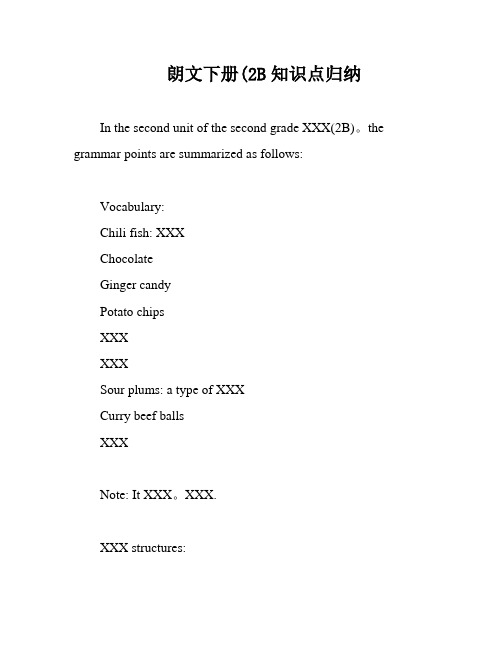
朗文下册(2B知识点归纳In the second unit of the second grade XXX(2B)。
the grammar points are summarized as follows:Vocabulary:Chili fish: XXXChocolateGinger candyPotato chipsXXXXXXSour plums: a type of XXXCurry beef ballsXXXNote: It XXX。
XXX.XXX structures:1.Too much is used for uncountable nouns。
while too many is used for countable nouns.2."I like cookies" XXX.3."Do you like cookies?" is a yes/no n.Positive answer: "Yes。
I do."XXX: "No。
I don't."4."I don't like cookies" XXX.5."XXX。
Note that when using third-person singular pronouns (he。
she。
it)。
the verb "like" is conjugated with an "s."6."Does Beeno like cookies?" is a yes/no XXX。
When using "does," the verb "like" is not conjugated with an "s."XXX: "Yes。
- 1、下载文档前请自行甄别文档内容的完整性,平台不提供额外的编辑、内容补充、找答案等附加服务。
- 2、"仅部分预览"的文档,不可在线预览部分如存在完整性等问题,可反馈申请退款(可完整预览的文档不适用该条件!)。
- 3、如文档侵犯您的权益,请联系客服反馈,我们会尽快为您处理(人工客服工作时间:9:00-18:30)。
二年级朗文英语下册B 语法知识点归纳
This model paper was revised by LINDA on December 15, 2012.
二年级朗文英语下册(2B)语法知识点归纳:
第一单元:
单词:
chill fish 麻辣鱼
chocolate 巧克力
ginger 姜糖
potato chips 薯片
lemon sweets 柠檬糖
peanuts 花生
sour plums 话梅
curry beef balls 咖喱牛肉丸
cheese rings 奶酪圈
注意:要能区分哪些是可数名词,哪些是不可数名词。
蓝色:不可数名词
红色:可数名词
句型:
1.太多了
too much 用于不可数名词
too many 用于可数名词
2. I like cookies. 我喜欢饼干。
3. Do you like cookies 你喜欢饼干吗
肯定回答:Yes, I do.
否定回答:No, I don’t.
4. I don’t like cookies. 我不喜欢饼干。
5. Beeno likes cookies. Beeno喜欢吃饼干。
(Beeno是第三人称单数,后面的动词like加s)
6. Does Beeno like cookies Beeno喜欢吃饼干吗(有了does,like不加s)
肯定回答:Yes, he does.
否定回答:No, he doesn’t.
7. Beeno doesn’t like cookies. Beeno不喜欢吃饼干。
有does或者是doesn’t,后面的动词like就不加s了。
第二单元
单词:
grape 葡萄
grapes 葡萄(复数)
orange 桔子
oranges 桔子(复数)
egg 鸡蛋
eggs 鸡蛋(复数)
sugar 糖
flour 面粉
butter 黄油
注意:要能区分哪些是可数名词,哪些是不可数名词。
蓝色:不可数名词
红色:可数名词
句型:
1.这里有…吗?
①Is there any ….
用于询问不可数名词。
例如:Is there any butter?
肯定回答:Yes, there is.
否定回答:No, there isn’t.
②Are there any …
用于询问可数名词,后接名词的复数形式。
例如:Are there any eggs?
肯定回答:Yes, there are.
否定回答:No, there aren’t.
2. 这里有…。
①There is… 后接可数名词的单数或者不可数名词。
例如:There is an egg.
There is some butter.
②There are … 后接可数名词的复数。
不可以接不可数名词。
例如:There are some eggs.
第三单元:
单词:
wash my face 洗脸
brush my teeth 刷牙
have breakfast 吃早饭
do my homework 做作业
have a shower 洗澡
go to bed 睡觉
句型:
1. It’s time to… 到了做…的时间了
to 的后面接动词原形
2.问现在几点了?
What’s the time?
What time is it?
3. 回答时间:It’s 后接时间.
4. 在早上in the morning
在下午in the afternoon
在晚上in the evening
5. 在深夜 at night
6. 在…时间 at+时间点
7. 第三人称单数后面的动词,加s或者es wash – washes
brush – brushes
have – has
do – does
go – goes
第四单元:
单词:
wash the dishes 洗碗
set the table 摆碗筷
water the plants 浇水
sweep the floor 扫地
tidy the living room 整理客厅
make the bed 铺床
句型:
1. How do you help at home 你在家干什么活
2. I set the table.
3. How does Beeno help at home Beeno在家干什么活
4. He sets the table.
Beeno (人名、he 、she)第三人称单数,后接的动词加s
但是,以o、ch、sh结尾的动词,要加es,比如go、watch、wash。
5. 第三人称单数后面的动词,加s或者es
wash – washes
set – sets
water – waters
sweep – sweeps
tidy – tidies
make – makes
第五单元:
单词:
football 足球
basketball 篮球
volleyball 排球
badminton 羽毛球
tennis 网球
table tennis 乒乓球
句型:
1. What do you like doing 你喜欢做什么
2. I like playing football. 球类运动前面要用动词play。
like后面接的动词要加ing。
3. Do you like running 你喜欢跑步吗
肯定回答:Yes, I do.
第六单元:
单词:
Sunday 周日
Monday 周一
Tuesday 周二
Wednesday 周三
Thursday 周四
Friday 周五
Saturday 周六
go hiking 去爬山
go cycling 去骑车
go dancing 去跳舞
go swimming 去游泳
go ice-skating 去滑冰
go jogging 去慢跑
句型:
星期几的前面要用介词“on”
3. What does Beeno/ he/ she do on Monday?
Beeno he she 是第三人称单数,所以前面的do变成了does
He 或者She是第三人称单数,所以后面的动词要加“s”,但是以“o ch sh”结尾的动词,结尾改加“es”。
虽然they也是第三人称,但是they表示“他们”,是复数。
所以动词仍然用原型。
